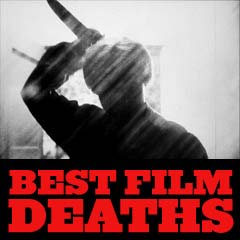
|
Deaths Scenes 1977-1978 |

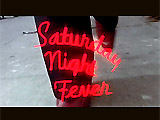
|
Director John Badham's classic urban drama/dance film starred John Travolta as a vulgar, blue-collar, Italian-American, Brooklyn-dwelling paint-store clerk - who became transformed on Saturday nights into pulsating, white-suited Tony Manero. The disco king strutted across a dance floor of rainbow-colored squares. In a nighttime scene during the tragic climax, Tony's friend Bobby C. (Barry Miller) was goofing around and showing off for his buddies on the Verrazano Narrows Bridge (connecting Brooklyn and Staten Island). Tony warned him repeatedly: "I'm not kiddin' Bobby. Get down from there," as Bobby hung from cables, tight-rope walked on the edge of the railing, and did a dangerous hand-stand. The suicidal, attention-seeking daredevil bragged: "I'm alright." Tony climbed down to him and extended his hand: "Come back in...You're making me very nervous now, Bobby." As the reckless Bobby rebuked and complained to Tony about not listening to him, phoning him, or caring about him (or his depressing plight that he had to marry his pregnant, devout-Catholic girlfriend Pauline), he lost his balance and took an accidental, deadly fall/plunge off the bridge, in view of all of his stunned friends. He plummeted into the water many hundreds of feet below, presumably breaking his neck or skull with the impact.
|
   Daredevil - With Lethal Consequences |
||||||||||||||||||
 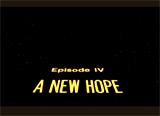
|
Star
Wars (1977) This first installment of George Lucas' long-running franchise became one of the most popular, profitable, entertaining, and successful science fiction/action - adventure/fantasy films of all time. Two formidable opponents confronted each other for a duel-to-the-death scene with laser light-sabers in the film's conclusion:
During the duel, Kenobi cautioned Vader: "You can't win, Darth. If you strike me down, I will become more powerful than you can possibly imagine." From a distance, Luke Skywalker (Mark Hamill) could see their combat and called out: "Ben?" When Kenobi looked and saw Luke, he smiled, lowered his guard, as Vader cut him in half. His robe fell to the floor, but he had vanished inside. Obi-Wan Kenobi suffered a sacrificial death and a mythical demise when he deliberately lowered his weapon in order to let Luke and the others escape, and suffered a fatal blow to the head. Ben had successfully diverted attention from the rest of the Falcon group and everyone (except Luke) reached the safety of the ship. Ben's death also released the Force from his body and it traveled to his companions. |
   The Deadly Light-Saber Duel |
||||||||||||||||||

|
Suspiria (1977, It./W. Germ.) There were many creative, brutally violent deaths/murders in Dario Argento's best feature film - about a German ballet academy run by witches. The most spectacular and flamboyant was the film's opening elaborate double-murder sequence. One helpless young blonde ballerina Pat Hingle (Eva Axen), recently expelled from the German dance academy, sought refuge in the nearby apartment of her friend Sonia (Susanna Javicoli). Pat was grabbed by the neck through a bedroom window by the bare arm of an unseen assailant, and had her face crushed against the window pane in front of her. With the pressure, her face crashed through the glass as she was repeatedly stabbed in the chest by the killer, while blood dripped from her mouth. The killer grabbed a rope (or electrical cord) and wrapped it around her body (with her arms pinned to her side), and then continued to stab her - into her exposed still-beating heart - as she laid on her back. Then, her face (and then her entire body) were shoved through a hole in the ceiling (a colorful stained-glass skylight window above the apartment's lobby area), only to be stopped in mid-fall by an electrical cord strung around her neck, that suspended her only a foot or two from the floor as blood dripped down from her body.
The camera panned over from the puddles of blood to discover her friend Sonia (Susanna Javicoli), a second victim on the first floor who had been vainly calling for help - she was bisected by the falling shard of glass and other objects from the ceiling's skylight.
Another horrific death scene involved the dance school's blind pianist Daniel (Flavio Bucci), who had his throat torn out by a vicious, unexpected lunging attack from his own seeing-eye dog in the middle of the school's empty piazza at night. Also, negligee-wearing, terrorized dancer Sara (Stefania Casini) escaped attack by crawling through a window high in a wall, only to tumble onto coils of razor wire before her throat was slit with a straight-edged razor by an unseen figure. |
   Seeing Eye Dog Attack on Blind Master  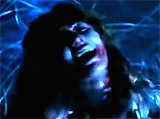   Razor-Wire and Throat-Slitting Death of Sara |
||||||||||||||||||

|
Michael Cimino's epic about war and friendship was a powerful, disturbing and compelling look at the Vietnam War through the lives of three blue-collar, Russian-American friends in a small steel-mill town, who all experienced the effects of the psychologically-wounding war. The most talked about sequences in The Deer Hunter were the contrived, theatrical, and fictional Russian Roulette tortures, imposed twice in the narrative - on the American POW's during wartime, and played as a game in a Vietnamese gambling den. The film's most stunning death scene was set in a smoke-filled gambling room in the heart of Saigon where the lethal game of Russian roulette was actively flourishing and led by a one-eyed referee. Michael (Robert DeNiro) winced as one of the young, red head-banded contestants blew his brains out. Addicted to the game, Michael's friend Nick (Christopher Walken) was glimpsed as he arrived to be the next player. He had become dehumanized by his war experience, was glassy-eyed, drugged-out, and heroin-addicted, and constantly playing Russian roulette for high stakes in the gambling casinos. Frustrated, Michael pleaded with Nick to leave, but his automaton-zombie friend didn't recognize him:
Michael daringly took another approach (to "play the American") - he bought himself into the game (with some of his own cash and some from the cynical Frenchman's bribe money) - risking suicide so that he could save Nick. The gambling crowd reached a howling, fever pitch when the two Caucasians faced opposite each other at the Russian roulette table, once again reunited. Trying to shock his friend into recognition - by recalling their time together in the POW shack, Michael begged Nick to leave with him: "We don't have much time, Nick." Nick took the gun - with one bullet, and pointed it threateningly at his temple, but there was no bullet. After being handed the gun for his turn, Michael asked rhetorically: "Is this what you want? Is this what you want? I love you, Nick." As he cocked and pulled the trigger, he also survived the first round, relieved that he was still alive. There had been a faint flicker of recognition on Nick's face, and Michael pleaded: "Come on, Nicky, come home. Just come home. Home. Talk to me." Michael delayed the game by grabbing his friend's hand that already clenched the gun for the second round, asking: "What did you do to your arms?" There were scars of needle-tracks up Nick's arm - and emotional scars too deep to reach, although Michael attempted to break through one last persuasive time:
Nick remembered Michael's hunting credo, but it was too late to save him. Nick blew his brains out with the next shot - one shot, living out the logical consequence of the code. The "one shot" hunting theme and the deadly Russian roulette gamble were tragically echoed in the death of Nick. Michael's mission to bring Nick home alive had failed. As blood spurted from his friend's temple, Michael was emotionally devastated and agonized over Nick's death. Howling with grief, he cradled his pal's head, pleading for him not to die: "Nicky, Nicky, don't, Nick, no!!" |
  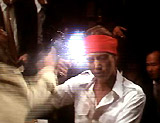  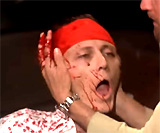  Film's 2nd Suicidal Russian Roulette |
||||||||||||||||||
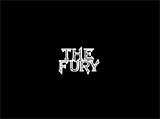
|
The Fury (1978) Brian DePalma's supernatural thriller (his follow-up film to the similar horror film Carrie (1976)) had an explosive and unforgettable conclusion. Secret government agent Ben Childress (John Cassavetes) suffered a slow-motion death when angry telekinetic high-school teen Gillian Bellaver (Amy Irving) exploded his body from the inside out. She had inherited a formidable power from psychically-linked Robin Sandza (Andrew Stevens) when he died. Earlier, Robin had been kidnapped and used by the nefarious Childress to harness his psychic powers for destructive purposes. As the gifted Gillian was being hugged by Childress, his eyes suddenly bulged and dripped blood, and he became blind. As he staggered in the room and shouted out: "Where are you?", the crazed girl summoned up her psychic powers and vehemently ordered: "You go to Hell!" She held her palms out toward him, and he began to violently convulse. And then he literally exploded in front of her - seen repeatedly from many different angles. The film ended abruptly.
|
   "You go to Hell!" |
||||||||||||||||||
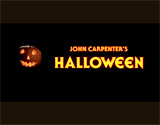
|
The opening, very-real, four-minute sequence in John Carpenter's classic horror film - a prologue of sorts - was justly famous for being filmed in a single take with a Steadicam (although there were a few imperceptible cuts). It also used a subjective, P-O-V camera to produce vulnerable, unsteady and off-balanced feelings. The setting was the small, quiet town of Haddonfield, Illinois on Halloween night in 1963, where children were celebrating Halloween - a normal and innocent-enough beginning. In the wood-framed Myers house, a figure (unidentified) voyeuristically watched from an outside porch window and then spied a teenage girl Judith Myers (Sandy Johnson) and her boyfriend Tommy (David Kyle) making out on the living room sofa through a side window. Judith mentioned that her brother "Michael is around someplace." They retreated to her upstairs bedroom where the 'peeping tom' noticed that they turned out the light (signifying that they were having sex). After witnessing the boyfriend leaving (calling back up the stairs with an obligatory promise to call her the next day), the subjective camera followed the mysterious figure to the back entrance and into the kitchen, where he took a large, menacing butcher knife from a drawer, proceeded through the house and then up the stairs. He picked up a clown's Halloween mask (with a large, red, phallic-like nose) and placed it on his face, allowing the audience to see a binocular-view through the eye-holes of the mask. Then, as he moved around corners and through doorways, he entered his near-naked sister's bedroom where he found her brushing her hair in front of a vanity table. After he surveyed her bedsheets, she turned and recognized her brother: "Michael!" The act of illicit sex stirred him to commit a hideous crime. Although she tried to defend herself, he furiously stabbed her to death in a brutal murder, and her bloodied body tumbled to the floor. The killer then descended the stairs and went out the front door.
The murderer was next seen unmasked - revealed in a shocking revelation as six-year-old Michael Myers (Will Sandin as boy) - the teenage girl's blank-faced, younger brother. The clown-costumed, insane boy stood there motionless, surrounded by shocked adults (his parents) on the front lawn, who had just pulled up. As he held the blood-dripping knife straight down in his outstretched right hand, a superbly-orchestrated crane shot slowly rose from him and widened the view, placing him within his quiet, suburban neighborhood. |
   Murder of Michael's Sister Judith by Masked Killer |
||||||||||||||||||

|
Another prominent death scene occurred later, when Lynda Van Der Klok (P.J. Soles) and her boyfriend Bob (John Michael Graham) drove up to the Wallace's house. They were drinking beer and "totally" excited about an upstairs sexual tryst in the "first bedroom on the left." Bob carried Lynda in his arms into the deserted house - anticipating the promise of sex. They made out on the sofa, watched by a black shadow revealed on the left of the frame when the camera pulled back. Glumly, babysitting friend Laurie (Jamie Lee Curtis) peered out the venetian blinds at the house across the street, thinking of the fun sexual escapades of her friends: "Everybody's havin' a good time tonight." After calling Laurie and learning that mutual friend Annie Brackett (Nancy Kyes/Loomis) would be returning soon and that young Lindsey Wallace (Kyle Richards) was "gone for the night," Lynda and Bob proceeded upstairs. As Michael's moving shadow appeared on the wall behind them while they were making love, a deep chord sounded. When Bob went to the kitchen to get beer after promising he'd be right back, he heard noises and heavy breathing in a closet. When he opened the closet's door, the masked Michael appeared (and stared at Bob quizzically for a moment as he tilted his head), held him high against the wall, and impaled him there with a large, shiny butcher knife. Wearing a white sheet draped over himself to cover his body - with Bob's glasses perched on his face - the killer stood in the upstairs bedroom doorway and tried to scare Lynda, but ended up fooling her into thinking it was her boyfriend under the sheet. She tantalized him, while sitting up naked in bed: "See anything you like? What'sa matter? Can't I get your ghost, Bob?" When he wouldn't speak back to her, she got up and phoned Laurie, but before she could say anything, Michael strangled her with the phone cord. Her distress cries sounded like the orgiastic moans of a prank phone call from Annie, and Laurie innocently misinterpreted her with a macabre question: "...Now I get your famous squealing? Annie, are you alright? Are you fooling around again? Well, I'll kill ya if this is a joke." Laurie believed that the caller was in the throes of passionate love rather than gasping for air and dying. |
  Bob Impaled With Wide and Gleaming Butcher Knife  The Killer Draped in Sheet  Myers' Strangulation of Lynda |
||||||||||||||||||

|
Watership Down (1978) This bleak, allegorical animated fantasy film, the most successful British animated feature of its time, was based upon Richard Adams' best selling novel. It told about the desperate quest of a warren of rabbits to find a new home, when their land was threatened with destruction during the construction of a housing development. In one violent sequence, villainous yet fearless rabbit dictator General Woundwort (voice of Harry Andrews) defiantly approached an invading farm-dog. Woundwort had come to the defense of Efrafan rabbits standing guard outside the warren, who were fleeing when the dog attacked. He called out: "Come back and fight. Dogs aren't dangerous." He jumped, in slow-motion, toward the fearsome blood-thirsty dog and suffered an off-screen death. No trace of Woundwort could be found, but the legendary battle-to-the-death was used by rabbit parents as a 'ghost story' to scare their 'kittens' into obedience. The narrator eulogized:
|
   General Woundwort vs. Farm-Dog |
||||||||||||||||||

|
Watership Down (1978) Also, there was the mystical, tearjerking, old age death of the heroic, tired and elderly bunny Hazel (voice of John Hurt), who was visited by the shadowy angel of death, named Black Rabbit (voice of Joss Ackland). Hazel was reassured of the warren's well-being before falling asleep on the grass and passing away - his spirit freely followed after and joined the Black Rabbit:
|
 Hazel Visited by Black Rabbit  Hazel's Spirit Rising  Young Rabbits Cavorting in the Warren |
||||||||||||||||||
(chronological by film title) Intro | 1915-1929 | 1930-1933 | 1934-1938 | 1939 | 1940-1942 | 1943-1945 | 1946-1947 | 1948-1949 1950-1952 | 1953-1955 | 1956-1957 | 1958-1959 1960-1961 | 1962-1963 | 1964-1966 | 1967-1968 | 1969-1970 1971 | 1972 | 1973 | 1974 | 1975 | 1976 | 1977-1978 | 1979 1980 | 1981 | 1982 | 1983 | 1984 | 1985 | 1986 | 1987 | 1987 | 1988 | 1989 1990 | 1991 | 1992 | 1993 | 1994 | 1994 | 1995 | 1995 | 1996 | 1997 | 1998 | 1998 | 1999 2000-2001 | 2002 | 2003 | 2004 | 2005 | 2006 | 2007 | 2008 | 2009 | 2010 | 2011 |